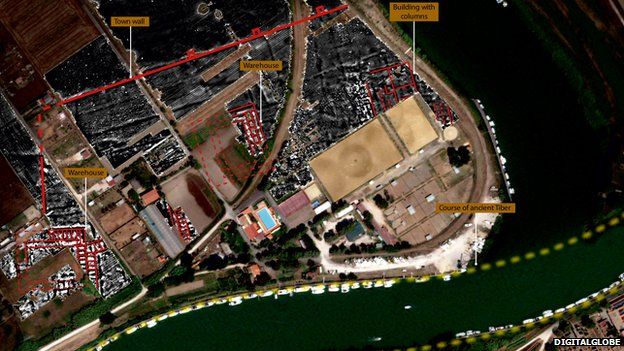Ancient Roman port 'larger than thought', researchers find
- Published

British scientists say a newly discovered section of the wall at the Roman port of Ostia shows the city was larger than previously thought.
It was uncovered during a survey of an area between the port and Portus - another ancient Roman port.
The ports are both about 30 miles (48km) from the Italian capital Rome.
Researchers from the universities of Southampton and Cambridge found the area enclosed three large, previously unknown, warehouses.
The largest of them was the size of a football pitch.
Scholars had thought the River Tiber formed the northern edge of Ostia, but the geophysical survey showed Ostia's city wall continued on the other side of the river.
Prof Simon Keay, director of the Portus Project, said: "Our research not only increases the known area of the ancient city, but it also shows that the Tiber bisected Ostia, rather than defining its northern side.
"The presence of the warehouses along the northern bank of the river provides us with further evidence for the commercial activities that took place there in the first two centuries."
The researchers used a technique known as magnetometry, where the landscape is scanned with handheld instruments to identify buried ancient structures.
These are mapped on a computer, providing images similar to aerial photographs, which archaeologists can interpret.
In antiquity, the landscape surveyed in this study was known as the Isola Sacra.
It was at its southern side that researchers found "clear evidence" for the town wall of Roman Ostia, which ran east to west for about 0.3 miles (0.5km) and was interspersed by large towers.
Evidence of the four large buildings were found nearby in an area known as the Trastevere Ostiense.
Prof Keay said: "Three of these buildings were probably warehouses that are similar in layout to those that have been previously excavated at Ostia itself, however the newly discovered buildings seem to be much larger.
"In addition, there is a massive 142m by 110m fourth building - composed of rows of columns running from north to south, but whose function is unknown."
The work was undertaken as part of the Southampton-led Portus Project, in collaboration with the British School at Rome and the Soprintendenza Speciale per i Beni Archeologici di Roma.
- Published8 October 2013
- Published22 September 2011
- Published1 October 2009
- Published7 August 2009
- Published25 July 2009